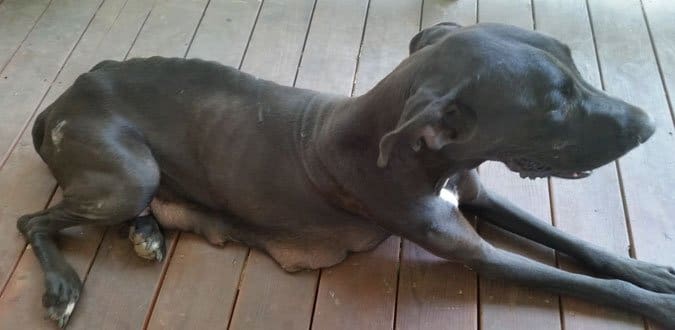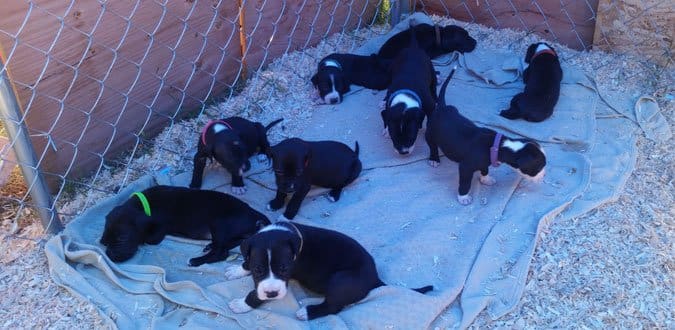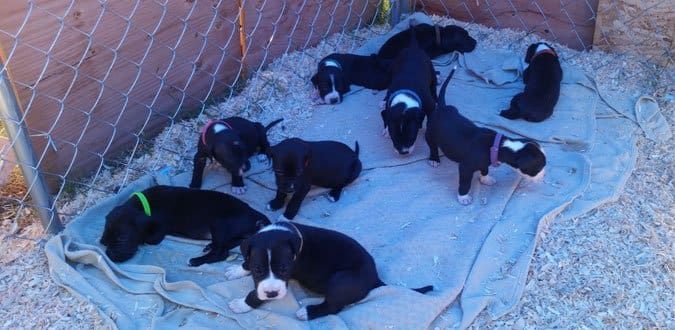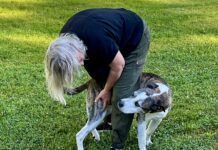On April 1, I was at the shelter, dealing with some paperwork aftermath of a bat encounter with my cat, when one of the front desk people asked me, “Are you going to take the puppies we got yesterday?” Keep in mind, the last of the nine cattle dog/pit-mix puppies I had fostered from about three weeks of age to 12 weeks had just gotten adopted. So I was like, “Naw, I think I’m going to take a little break.” But then of course I asked, “What kind are they?”
So I went to look at them, back in the isolation section of the shelter. It’s such a misnomer. It’s the most crowded, loud, stinky part of the shelter, because it’s where all the dogs from the unincorporated areas in my county are initially held when they are picked up as stray, or brought in as purported stray, or surrendered by their owners. Also held here are dogs from my town in identical situations, and dogs from two outlying Native American reservations. If they go some days (sometimes weeks) without being claimed, and they are judged as adoptable, and they have recovered from the inevitable kennel cough that is always present at the facility, in waxing and waning amounts, the lucky ones get moved into a second part of the building, the adoption kennels.
One look and of course I said I’d take the puppies: seven pups, about four weeks of age, that looked like German Shepherd/hound mixes, with maybe an Akita thrown in for good measure. Two had fluffy coats – a disaster in a shelter pen, where dogs and especially puppies are going to be wet for a good part of every day; there is no way to keep a crowded concrete kennel clean without hoses, and with seven pups in one pen, a certain amount of walking through each other’s poop and pee is expected.
We had some ups and downs. For the first week, the pups were really missing their mom, and didn’t want to eat anything I had to offer, and I offered them EVERYTHING: puppy formula of course, but also various types of canned food, soaked dry food, rehydrated dehydrated food, and tons of things from the fridge. My sister roasted a chicken and brought broth, and then rice she made with the broth, and the chicken itself. It took a while, and a lot of incredulous looks from my crew of dogs, who enjoyed a lot of rejected puppy food, but eventually they all started eating, and finally gaining weight, strength, and health. And they went back to the shelter, and were altered. Five were adopted within days – two to two different friends of a person who adopted one of my six foster pups from LAST summer!! – but I held two back from shelter placement, hoping to find homes for them with someone I knew personally.
I fell in love with these two, and had prospective homes for them: one with a friend who has a four-year-old daughter, and one with my trainer friend Sarah Richardson, who has an excellent training business (The Canine Connection) in the next town over from me.
As it turned out, neither home worked out, and both puppies found perfect homes anyway. My friend’s daughter, though she talks a lot about dogs, seemed indifferent to both the puppies and to my own friendly dogs. She meowed a lot, though; Dad, I think she’s trying to tell you something! And Sarah decided that now is not the time for a puppy. This past year, she’s lost two of her senior dogs, but felt an addition to her pack now is not right. Instead, she endorsed the puppies on her Facebook page, and within days, had found them both really amazing, perfect homes with former clients.
But her photos and discussion of the pups initiated one comment that jolted me – just as it has jolted me every time I’ve mentioned in this blog the pups that I’ve been fostering, pretty much nonstop since November. When I’ve discussed raising the pups until they are big enough and strong enough to return to the shelter for spay/neuter surgery, so they can be adopted, someone ALWAYS says, “What a shame they have to be altered so early, it’s so bad for their health.” Sometimes, the person adds, “Shame on WDJ for promoting this.”
Occasionally, I explain that this page is a blog post: a place where I can have personal discussions and ask for personal reflections and opinions from other dog owners. It’s not a Whole Dog Journal “article,” which would offer facts about practices like the pros and cons of pediatric spay/neuter. We did that article in the magazine in 2013: “Risks and Benefits to Spaying/Neutering Your Dog“.
My personal opinion is this: Yes, it’s absolutely healthier for any individual animal to be intact, not altered, particularly at such an early age. It’s not ideal. But neither is the fact that my shelter ends up with so many damn puppies in the first place. But state law (here in California, anyway) requires that all dogs and cats that are adopted from a shelter are altered. While some rescues might have the means to foster puppies until they are far older, my shelter is not. I am sort of it for my shelter’s ability to handle large litters of puppies (without losing any) at all.

People who have lost a dog to a certain cancer, or lost time/money/health to certain conditions that may be related to early spay/neuter, such as joint disease, or a CCL rupture, may well feel strongly that dogs not be altered early, or perhaps not at all. I sympathize with that stance. But as long as the incoming tide of puppies and dogs into my shelter is bigger and more relentless than the outgoing tide of adopted dogs and puppies, I will always adopt altered animals, and encourage anyone who isn’t in the market for a purpose-bred dog from a responsible breeder to save an altered shelter dog, instead.
Literally the day after my last foster pup’s adoption was finalized, I had a text from my shelter’s veterinary technician. “We have a starved Great Dane mom and her 11 puppies. Can you help?”
Of course. But dammit.







